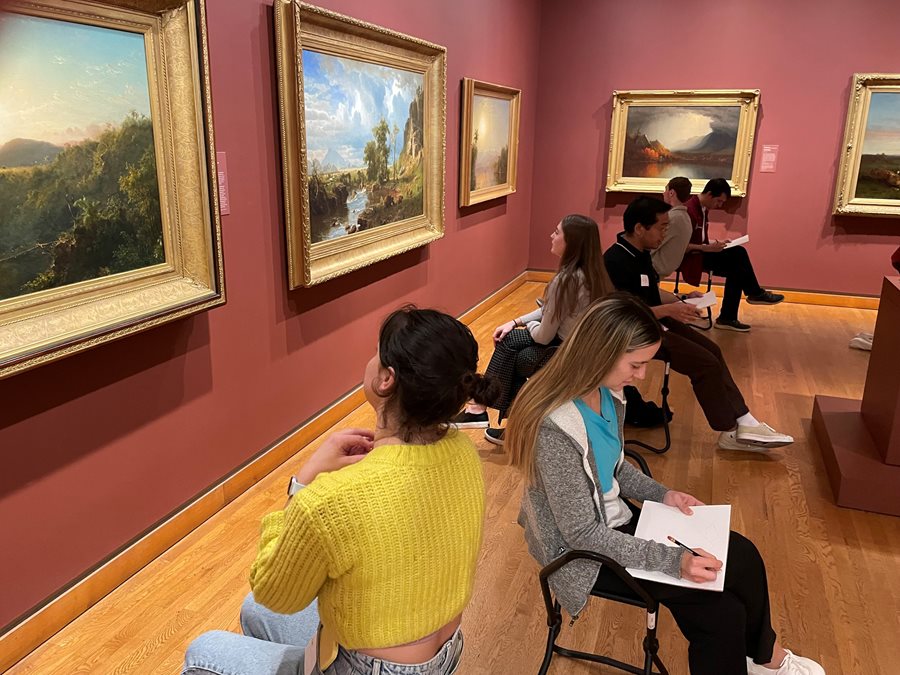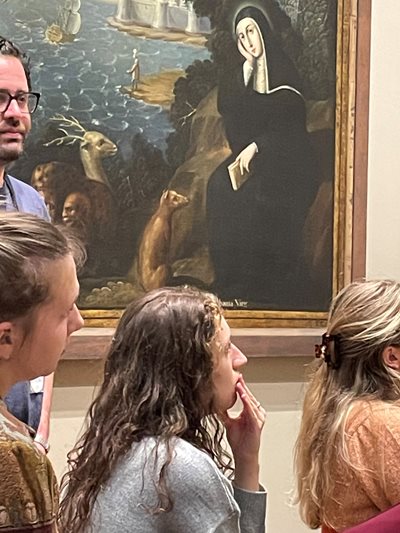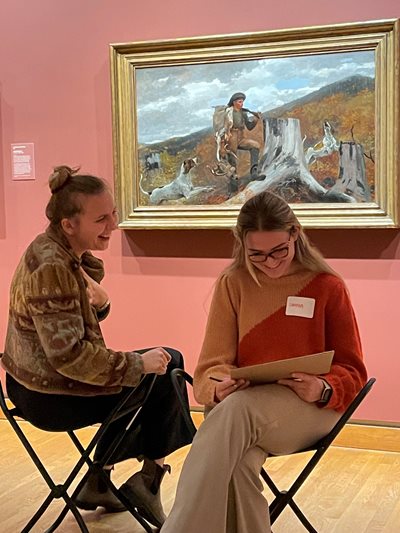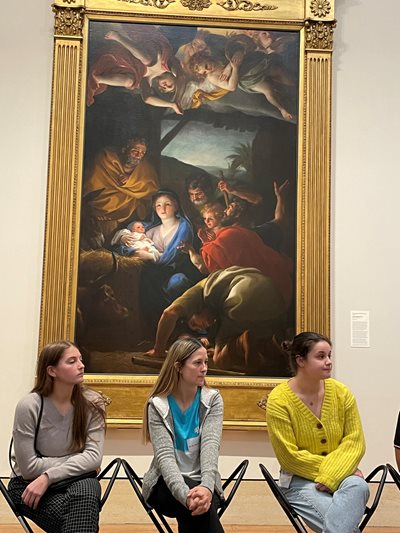 As classmates in the Physician Assistant (PA) Studies program at Salus University, Huntur Woodard ‘24PA and Jacob Spivack ‘24PA, speak the same PA “language.”
As classmates in the Physician Assistant (PA) Studies program at Salus University, Huntur Woodard ‘24PA and Jacob Spivack ‘24PA, speak the same PA “language.”
That common communication capability came in quite handy recently when a group of 12 Salus PA students visited the Philadelphia Museum of Art to participate in a program called “The Art of Observation.”
A unique combination at the intersection of art and science, the program helps healthcare students improve their technical skills in observation, interpretation, perspective-taking, recognizing bias and empathy, all with the intent of applying those same skills to clinical practice.
 According to Jeanne-Marie Pucillo, MSPAS, PA-C, clinical coordinator for the University’s PA program, an exercise like this helps the students stop and look rather than make assumptions when walking into a room to assess a patient.
According to Jeanne-Marie Pucillo, MSPAS, PA-C, clinical coordinator for the University’s PA program, an exercise like this helps the students stop and look rather than make assumptions when walking into a room to assess a patient.
“Sometimes we tend to allow our biases to affect what we see. This helps the students recognize their biases early on in their career and understand how to work past those,” she said.
Among the activities the students participated in was for all to sit in front of a painting, dividing it visually into four quadrants, then discussing the details of what they observed in each section of the painting. To build upon that activity, another exercise required the students to pair up with a partner, with one person facing a painting and the other facing away from the painting with a sketchpad. The person facing the painting was asked to describe what was in the painting, focusing on quadrants, while the other was asked to sketch out what was being described.
That’s where the common PA “language” was an asset to Woodard and Spivack.
 “In PA school, we’re learning a vocabulary that helps us identify specific portions of the human body and we’re learning terms that are going to help us identify and separate different elements of the body and where they are located,” said Woodard, who hails from Hanover, Pennsylvania. “We were able to translate those specific terms to just a square picture or a painting. Because we both are in the program together, I know he knows these terms and he knows I can use these terms, too so the vocabulary was very fluid between us.”
“In PA school, we’re learning a vocabulary that helps us identify specific portions of the human body and we’re learning terms that are going to help us identify and separate different elements of the body and where they are located,” said Woodard, who hails from Hanover, Pennsylvania. “We were able to translate those specific terms to just a square picture or a painting. Because we both are in the program together, I know he knows these terms and he knows I can use these terms, too so the vocabulary was very fluid between us.”
Spivack added that when looking at something like a painting, it’s difficult to see all the details and describe them to someone else.
“So, when talking about a problem a patient might have, like something on their body for example, the patient might not be able to see it themselves or be able to describe it in their own words,” said Spivack, of Philadelphia. “Explaining what a lesion might look like, where it is located and going into details about it is important. Not only in terms of making a diagnosis but making sure the patient knows what their issue is or if they have an issue at all.”
Lavinia Kitson ‘24PA said it’s important for PAs to not be led by generalizations or subjective opinions when diagnosing a patient. She believes the objective observations the students practiced during their time at the museum will be invaluable moving forward in the program.
“I think with any healthcare provider, it’s important to be objective in your descriptions to patients,” said Kitson, who is a native of West Chester, Pennsylvania. “Really analyzing each individual complaint or symptom or significant test finding in an objective manner is important for making sure that you don’t include any of your own personal biases into making a decision on the diagnosis or treatment or even how the patient would perceive their own health and condition.”
 According to Suzannah Niepold, manager of teacher services at the museum, the program has been offered to health science students for the past eight years – originating with the University of Pennsylvania course and publicity about the importance of developing and refining observation, communication, and evidential reasoning skills among their medical students. But because of the pandemic that shut down the museum for a while, area students have just started participating in the program again. Past Salus PA students participated in the program pre-pandemic, and PA classes resumed participation in the spring of 2022.
According to Suzannah Niepold, manager of teacher services at the museum, the program has been offered to health science students for the past eight years – originating with the University of Pennsylvania course and publicity about the importance of developing and refining observation, communication, and evidential reasoning skills among their medical students. But because of the pandemic that shut down the museum for a while, area students have just started participating in the program again. Past Salus PA students participated in the program pre-pandemic, and PA classes resumed participation in the spring of 2022.
“The interesting thing is that I think the original goal established by medical schools was that they want their students to improve their observation skills, they want to transfer the art observation skills to clinical observation skills. They want to talk about things like bias and increased empathy,” said Niepold.
But she added that over the life of the program, both museum officials and healthcare students have gleaned another big benefit: the chance to step out of the classroom and use their brains in a different way to relieve stress.
That was certainly true for Salus PA student Lenka Voguslawski ‘24PA. She said that at this point in the current semester, the students are into a heavy exam schedule and the pressure and stress is palpable.
“It was nice to take a step back and not really have to use my brain in terms of retaining information. At school, it’s memorize, memorize, memorize and try to learn it,” said Voguslawski, who is originally from Seattle. “Today it felt more relaxing. It was nice using my brain in a different way.”